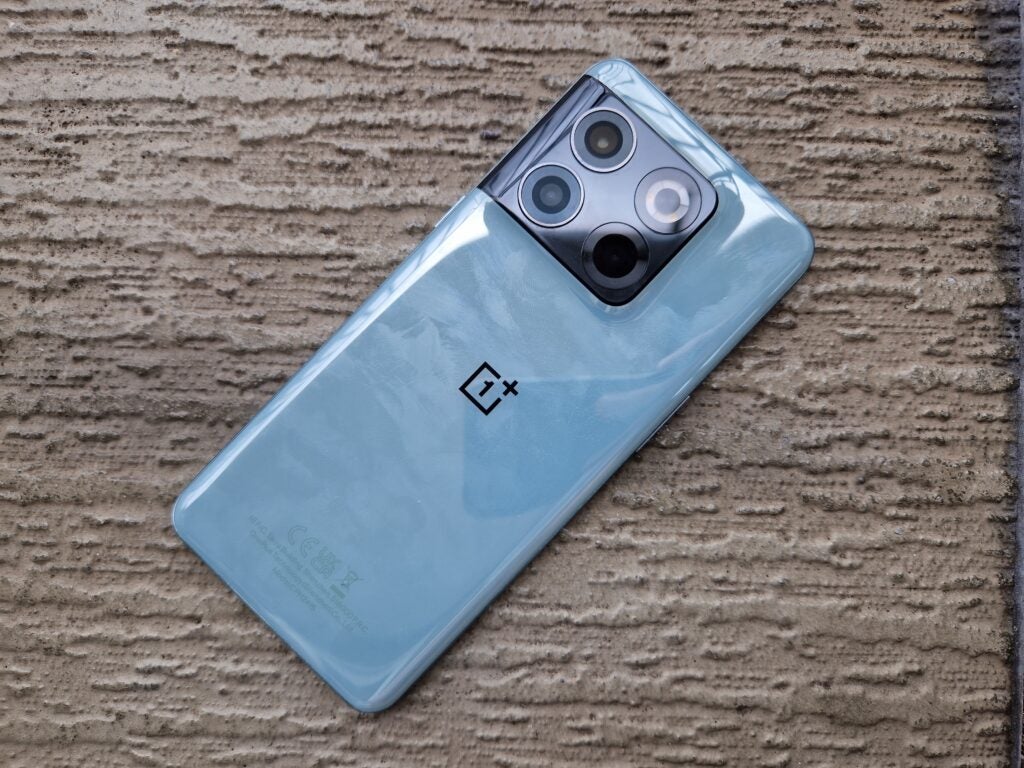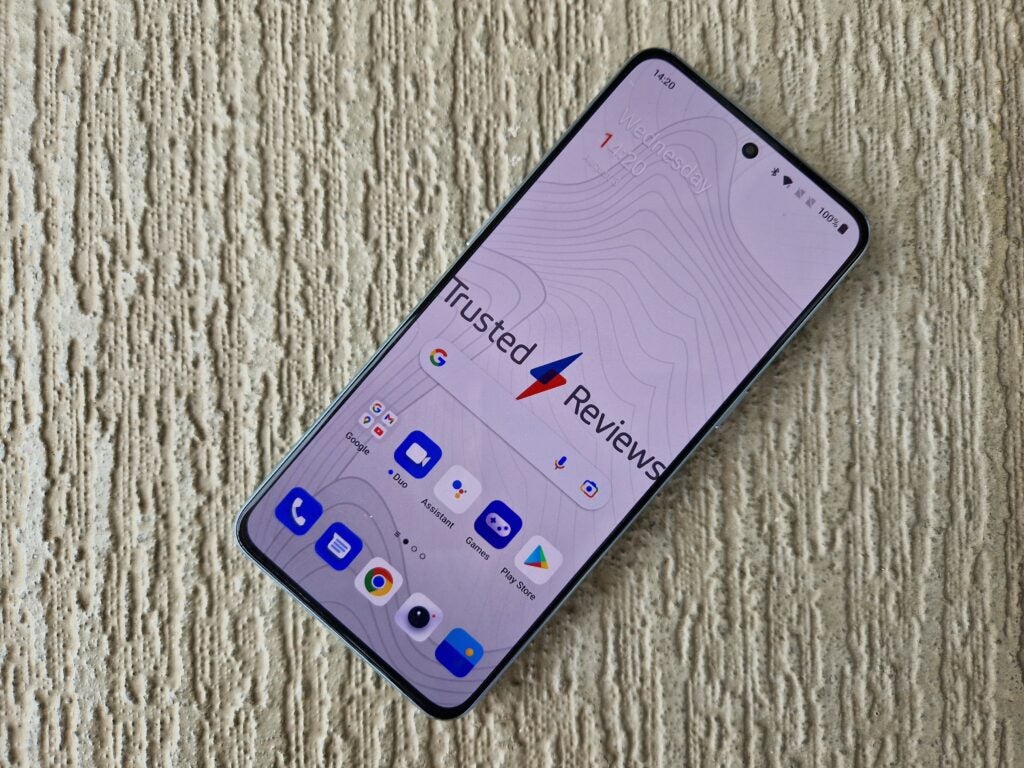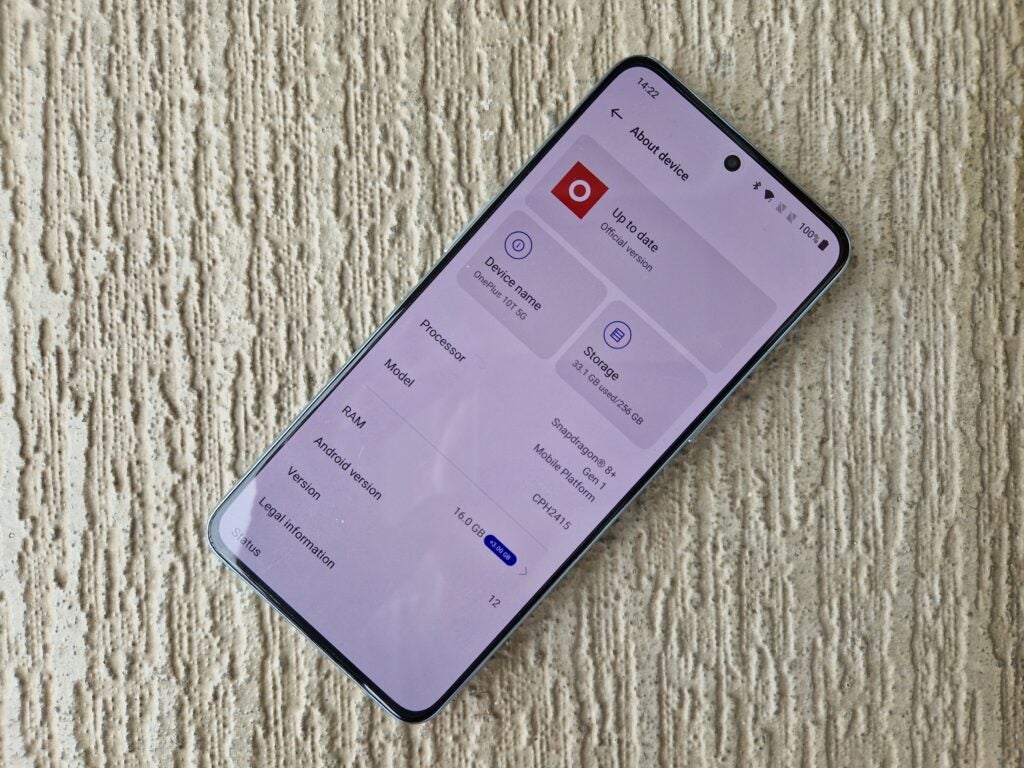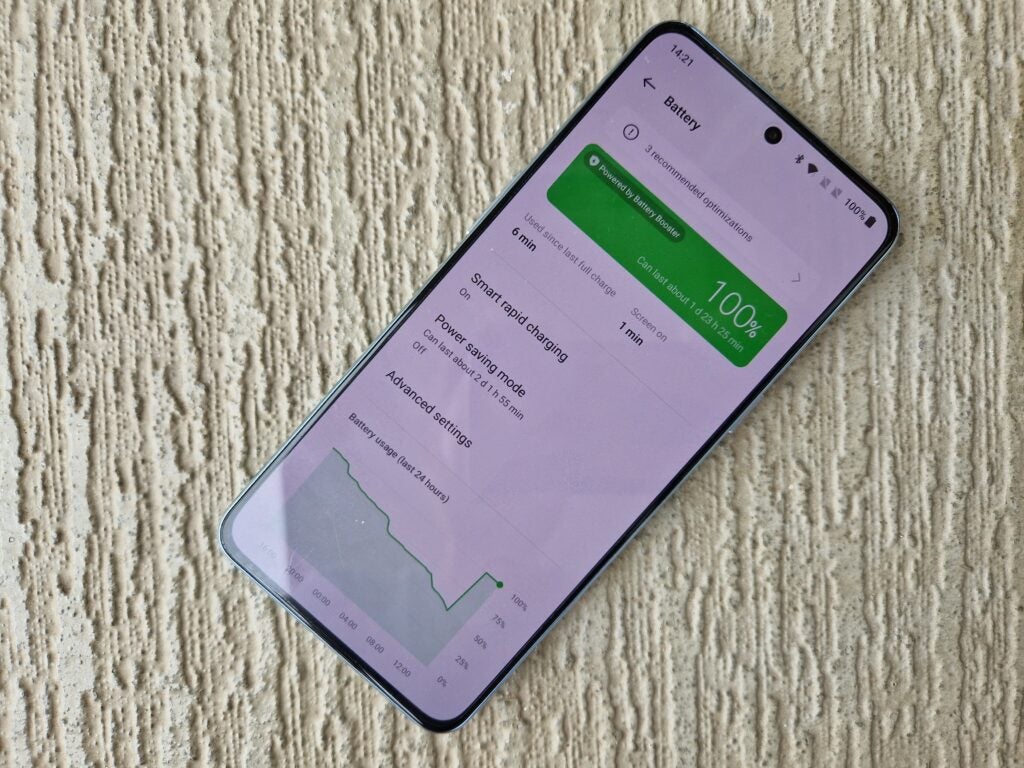Verdict
The OnePlus 10T excels in some areas, with its performance, fast-charging, and screen being among the best in the business. However, the camera isn’t as good as rival flagships’.
Pros
- Excellent performance levels
- Great screen
- Brilliant fast-charging
Cons
- Middling camera
- Controversial design
- No IP rating or wireless charging
Availability
- UKRRP: £629
- USARRP: $699
- EuropeRRP: €699
- CanadaTBC
- AustraliaTBC
-
High-spec screenThe OLED display measures 6.7-inches and has a 120Hz refresh rate, a 1,000Hz touch sampling rate, HDR10+ support and 10-bit colour -
Top-tier processorThe OnePlus 10T runs on the Snapdragon 8 Plus Gen 1, Qualcomm’s latest flagship chipset -
50-megapixel main cameraThe device’s main sensor has a 50-megapixel resolution
Introduction
Having released the flagship OnePlus 10 Pro earlier this year the brand is back with the OnePlus 10T, a device which it claims represents “a holistic performance upgrade for users.”
There certainly are some clear upgrades here, including the adoption of the Snapdragon 8 Plus Gen 1, but equally noteworthy is a rehaul of the camera system that does away with a telephoto lens in favour of a macro sensor, and the omission of the manufacturer’s once-trademark notification slider.
Is this model really a big step forward, or is OnePlus treading water? Read on to find out, as we put it to the test.
Design and Screen
- Attractive glossy back
- Clunky camera module
- Gorgeous screen
- No IP rating
The design, which is very similar to the OnePlus 10 Pro, is once again likely to split fans down the middle. I wasn’t a huge admirer of the previous device, but there are a few slight tweaks that I do appreciate about this one.
For one thing, the camera bump is a lot smoother than its predecessor, even though it is still just as visually intrusive, and the glossy jade green backing is certainly a subtle treat for the eyes. It does pick up a couple of smears, as glossy backs do, but I felt that the gentle green shade didn’t show these up too much.

As I’ve used this phone I have adjusted to its bulky camera module, which is unlike those of any other phone on the market in the way that it asymmetrically dominates the back panel; however, when asking my friends’ opinions of the looks, there have been universally negative responses. At the very least, if the cameras are so noticeable then they should be excellent performers; more on that later.
Another change made from the previous model to this one is the removal of the notifications slider. On previous OnePlus phones, this allowed you to easily flick notifications to aloud/ vibrate/ silent, and many users appreciated the ease of this process. Personally I don’t consider it a great loss, as my personal preference is to always keep the phone on vibrate, but I can understand why some fans might be sad to see this hallmark of the series be absent.
There was a similar adverse reaction from the fanbase when the 3.5mm headphone jack was removed, and that change has stuck to this day, and there’s no expandable storage available via MicroSD card either. What’s more, there’s no stated IP rating so we don’t know for sure how it would perform if exposed to water or dust, but the phone is at least fairly well protected from scratches and scuffs on the front and the back thanks to Gorilla Glass 5. It also comes with a pre-installed screen protector to boot, and it’s a screen that’s seriously worth protecting.

I really enjoyed using this device’s display, which is smooth, responsive, and punchy. There are more high-end screen specs than you could shake a stick at here, including an adaptive 120Hz refresh rate which ensures smoothness and a degree of battery conservation (though it can only adjust between 60/90/120Hz), and a touch response rate of up to 1,000Hz which means that it’s lightning-quick to respond to physical input, a particularly handy feature for competitive gaming.
The display offers 10-bit colour, which means over one billion colours are supported, and it’s got HDR10+ on board too for that extra punch when running supported content. The resolution is 2412x1080p, which is sharp though not exceptionally so, and the peak brightness is claimed to be 950 nits.
All this tech comes together magnificently, delivering a superb screen experience for the phone. Whether you’re watching nature video compilations on YouTube, where the full spectrum of colours is present to marvellous effect, or playing high-octane video games, which seem smoother than ever, it’s a real joy to put this display to use and I couldn’t get enough of it. If you mostly use your phone for watching videos and mobile gaming, then you should definitely consider this one.
Camera
- Decent main camera
- Tonal inconsistencies between lenses
- Telephoto sensor ditched for a macro sensor
- Underwhelming cameras overall
The OnePlus 10T has a triple lens camera, as is made all too obvious by its attention-seeking design, and the three sensors in question are a 50-megapixel wide-angle, an 8-megapixel ultrawide, and a 2-megapixel macro camera.
That last one is a particular disappointment for me; it’s the kind of unnecessary feature we find all to often on cheap phones, not one that costs up to £729, and I’d have much rather seen a proper telephoto in its place.
However, its inclusion was likely a cost-cutting measure, and you can make use of digital zoom if you want to get closer to your subject. You’ll also notice that there’s no Hasselblad branding on the camera or its app this time round, so we can assume that the prestige camera brand did not aid in its development.
Below are some photos taken with the main sensor:



These images were fairly pleasing, giving a decent amount of detail thanks to that 50-megapixel resolution. That said, they’re not on the same level as the similarly-priced Google Pixel 6, so that might be a better option if you love taking snaps.

Unfortunately though, one of the problems I found with the OnePlus 10 Pro is back here with a vengeance, and that’s the tonal inconsistency between the wide angle and ultrawide lenses. For comparison, take a look at the beach in the image above (taken with the wide angle) and below (ultrawide) to see just how jarring it can be when flicking through a gallery of photos taken on this phone.

As mentioned, there’s no telephoto lens here so you’ll have to make do with the digital zoom capabilities if you want to move in for a closer look. While some phones can nearly get away with doing this, there’s quite a loss of detail with the OnePlus 10T’s digital zoom even at the default 2x marker, with images nowhere near as sharp as normal:

When the lights are low but you still want to take some snaps, OnePlus has got Nightscape 2.0 technology onboard, in order to capture photos with “improved brightness, sharpness and detail.

As you can see from the above image, Night Mode does deliver reasonably sharp pictures, with noise having been significantly reduced, and so it’s a useful feature to have this available – and what’s more, there’s not a long waiting period for it to take effect when you press the shutter button.
Turn the phone around, and there’s a 16-megapixel selfie camera staring back at you:

Results from this camera are noticeably less sharp than most other rivals at this price, and the pictures lack the wow factor that you probably want to see when taking pictures of yourself. However, it still delivers an efficient bokeh effect in Portrait Mode, which cuts neatly around the subject to make it stand out.
Performance
- Powerful processing
- Appealing software
The OnePlus 10T is one of the first smartphones to run on Qualcomm’s new flagship chip, the Snapdragon 8 Plus Gen 1. We’ve already seen this in action on the Asus ROG Phone 6 Pro gaming phone, where it excelled, and that’s the same case here.
The OnePlus 10T has posted very strong CPU benchmark scores, as you can see in the below table, where it holds its own against other Android flagships. It’s not quite as souped-up as the aforementioned ROG Phone, but be in no doubt that this is still a smartphone than can handle itself very capably, and will run even the most demanding apps. Scroll across the table below to see exactly how it stacked up compared to its peers:
Day-to-day performance was also highly impressive; I never noticed any lag, slowdown, or performance glitches during my time with the phone, and high-end games ran without a hitch too. This processor in tandem with the excellent screen made gaming a particular delight, and it’s certainly a good handset to consider if games are one of your favourite hobbies.
Beyond the processing power, connectivity is a key focus of this device. I’m not just talking about dual band Wi-Fi, 5G, Bluetooth 5.3, NFC, and the full gamut of satellite positioning tools, all of which are indeed present and correct, but OnePlus has also claimed to have refined its connectivity in other ways.
One is Smart Link, which is intended to improve upload signals and speed by avoiding network congestion, and the other is its system of 15 antennae which is intended to deliver stronger cellular Wi-Fi and mobile data connections regardless of how the device is held in your hand. For what it’s worth, connectivity certainly always remained strong in my time with the device.

The OnePlus 10T runs on Android 12, with the OxygenOS 12.1 user interface. The manufacturer has stated that you’ll get three major Android version updates and four years of security updates over the lifetime of this device, which is pretty good going by the generally low standards of Android OEMs.
OxygenOS is a light-touch Android skin that fortunately doesn’t add tonnes of bloatware to your handset, but does ass a few helpful little tricks. There’s a handy in-game menu for when you need to change the settings while you play, and I’m a fan of the Shelf drop-down which houses widgets on the home screen.
Battery Life
- Decent but not brilliant battery life
- Incredible fast charging
- No wireless charging
The OnePlus 10T has a 4800mAh battery, spread across two cells, which is a decent capacity but after all it has got a large and demanding screen to run. OnePlus claims that it can deliver 26 hours of usage on a single charge, but I have to say that I’m surprised by this claim; in my experience, the battery drained a tad faster than that.
To give a few examples where I was keeping track of the battery life, I noticed that the battery fell from 77% to 69% after half an hour of intensive gaming, and from 66% to 58% after watching videos for an hour. Streaming music saw the battery fall by four percent over the course of an hour.
This is by no means terrible battery life, but I did feel that I needed to keep an eye on the battery percentage and curb my usage a bit if I wanted to have some juice left at the end of a busy day. On the other hand, when left on standby overnight it only lost 3% battery, which is very good going.

While the battery is decent but not particularly distinguished, the fast-charging is among the very best that I have ever witnessed. Rated at 150W, we saw the OnePlus 10T tick up from 0% to 50% in just eight minutes, and then all the way up from there to 100% in another eleven minutes for a total of 19 minutes from 0-100%.
As a result, charging feels like no hassle at all; it’s as if you turn your back momentarily and return to find the device fully topped up. It’s such a convenient feature that completely allays any fear of your phone not having enough battery when you leave the house.
Some customers may be concerned that such speedy charging may damage the battery, but OnePlus is keen to head off these worries by citing a couple of technologies at play to preserve the battery as best as possible. The first of these is the Battery Health Algorithm, which tracks and controls the charging current in an attempt to reduce the likelihood of dead lithium cells, while the Battery Healing Technology allows electrodes to be repaired during charging cycles.
OnePlus claims that these technologies will allow the phone to retain 80% of its original capacity after 1,600 charging cycles (equivalent to four years’ usage), but obviously I’ve not used this device on a long-term basis so can’t prove or disprove these claims.
The charging brick (which is actually capable of 160W charging) is included in the box along with its USB-C cable for all your wired charging needs, but this handset is not capable of wireless charging.
Latest deals
Should you buy it?
If you want a powerful smartphone with a great screen then this one delivers on both counts, in style.
If you love taking pictures with your phone then this might not be the best choice, as there are better camera phones for the price
Final Thoughts
The OnePlus 10T has some alluring feathers in its cap, those being the great performance that it squeezes from the Snapdragon 8 Plus Gen 1 chipset; the reality-defying speed of its 150W fast-charging; and its lush screen, which is particularly well-suited to running demanding video games. For all of those reasons, I really enjoyed using this phone on a day-to-day basis.
However, while the main camera is pretty good, it’s not on the same level as rivals like the Pixel 6, and its secondary sensors are rather disappointing. On top of that, it lacks a couple of the features you may expect to see on a device of this price, including an IP rating to show its dust and water protection, and a wireless charging capability.
How we test
We test every mobile phone we review thoroughly. We use industry standard tests to compare features properly and we use the phone as our main device over the review period. We’ll always tell you what we find and we never, ever, accept money to review a product.
Used as our main handset during test period
Camera tested in variety of situations with all modes
Tested with synthetic benchmarks and real world use
FAQs
It’s available in Jade Green (pictured) and Moonstone Black
Yes, you can get 5G data speeds providing that you’ve got network coverage and a compatible SIM card
It runs on Android 12, with an Oxygen 12.1 user interface, and the manufacturer has stated that it will be eligible for three major Android version updates and four years of security updates
Trusted Reviews test data
Sustainability
TrustedReviews’ holds the fact that global warming is not a myth as a core value and will continuously endeavor to help protect our planet from harm in its business practices.
As part of this mission, whenever we review a product we send the company a series of questions to help us gauge and make transparent the impact the device has on the environment.
We currently haven’t received answers to the questions on this product, but will update this page the moment we do. You can see a detailed breakdown of the questions we ask and why in our sustainability info page.
Jargon buster
mAh
An abbreviation for milliampere-hour and a way to express the capacity of batteries, especially smaller ones in phones. In most cases the higher the mAh, the longer the battery will last but this isn’t always the case.
5G
Offering faster download and upload speeds when compared to 4G. Great for game streaming and HDR video playback. Not supported everywhere yet and speeds vary wildly.
IP rating
An abbreviation for ‘Ingress Protection Code’, which lets you know to what extent a device might be waterproof or dustproof.
























